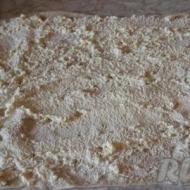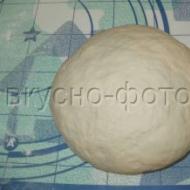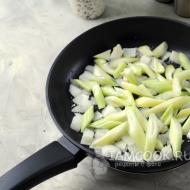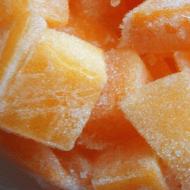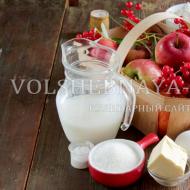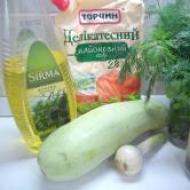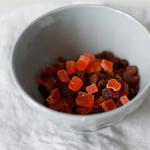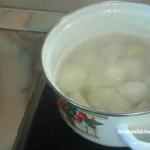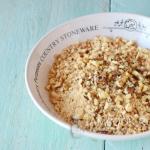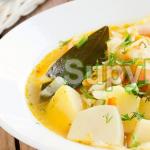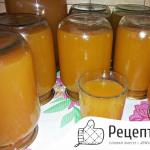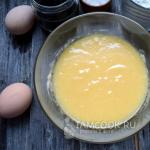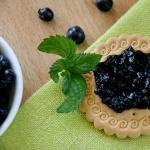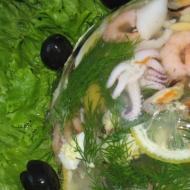
Useful properties and contraindications of nutmeg. Nutmeg Nutmeg how it grows
Nutmeg (Myristica fragnans) is an evergreen tree and belongs to the Nutmeg family. It is also called nutmeg or nutmeg tree. In German the plant is called Bandanuss, Suppennuss, Muskatsamen, in English - nutmeg, in French - noix de muscade.

Appearance
Nutmeg is a tree that in the wild can grow up to 20 m, but on plantations you can hardly find nutmeg taller than 6 m. Its leaves are leathery and dark green in color. They reach a length of up to 0.15 m, sit on short petioles, are pointed in shape, reminiscent of a lancelet.

Nutmeg trees can be male or female and produce white and yellow flowers. The flowers of the female tree produce yellow fruits with seeds, similar to apricots. They are represented by single-seeded berries enclosed in a smooth woody shell.
The shell is surrounded by a bright purple apricle - nutmeg color or, as it is also called, mace.

Nutmeg seeds have a brown tint and a mesh surface, reach a length of 0.2 cm, each weighs 4 g. A marble pattern is formed in the cross-section. Nutmeg fades when dried and becomes an orange to soft brown color. Macis reaches several centimeters in length.
Kinds
Nutmeg has nine species, among which only fragrant nutmeg is the most important.

Where does it grow?
The origin of nutmeg is known - these are the Moluccas, or more precisely, the Indonesian Banda Islands. Now it is more common in the southern and southeastern countries of Asia, South America, as well as in eastern Africa and the island of Madagascar.
The second supplier of nutmeg in the world is the small island of Grenada, which belongs to the Lesser Antilles.

Method of making spices
As a rule, nutmeg is grated immediately before adding to a dish, since when crushed it quickly ceases to be as aromatic. Macis is dried and crushed, and then added to dishes. Spices have completely different taste and aroma qualities, so they cannot be replaced with each other.


How and where to choose a spice?
Mace is much more difficult to find than nutmeg, which is sold ground or whole. It is preferable to buy it whole, since in powder form it quickly loses its aromatic qualities.
High quality nutmeg can be easily identified by poking it with a needle, causing it to release a little oil. The color of the nut should be bright. A network of wrinkles runs throughout the nut, and the cut has an interesting marble pattern.


Peculiarities
Nutmeg and mace have a spicy, sweetish aroma, but mace has a more subtle and soft aroma. The nut has a more tart and resinous taste. Nutmeg contains between 30% and 40% oil.
You cannot eat more than 4 g of nut, as it causes poisoning.

Characteristics
Nutmeg has the following characteristics:
- used as a spice;
- used for medicinal purposes;
- grows in tropical regions;
- Harmful if consumed in excess.

Nutritional value and calorie content
100 grams of ground nutmeg contains 525 kcal.
The nutritional value of the product includes the following components:
- proteins – 5.84 g;
- fats – 36.31 g;
- carbohydrates – 28.49 g;
- dietary fiber – 20.8 g;
- ash – 2.34 g;
- water – 6.23 g;
- monosaccharides and disaccharides – 28.49 g;
- saturated fatty acids – 25.94 g.
More information about nutmeg can be found in the excerpt from the program “1000 and One Spice of Scheherazade”.
Chemical composition
Nutmeg contains the following components:
- vitamins: A (RE) - 5 mcg, B1 (thiamine) - 0.346 mg, B2 (riboflavin) - 0.057 mg, B6 (pyridoxine) - 0.16 mg, B9 (folic) - 76 mcg, C - 3 mg, PP (niacin equivalent) – 1.299 mg, choline – 8.8 mg, β-carotene – 0.016 mg;
- macroelements: calcium – 184 mg, magnesium – 183 mg, sodium – 16 mg, potassium – 350 mg, phosphorus – 213 mg;
- microelements: iron – 30.4 mg, zinc – 2.15 mg, copper – 1027 mcg, manganese – 2.9 mg, selenium – 1.6 mcg.
Nutmeg contains elemicin, myristicin, safrole, etc. Many components cause an intoxicating effect.
Beneficial features
Nutmeg contains many vitamins, but the list of its beneficial qualities does not end there:
- it helps with insomnia and nervous disorders;
- strengthens the immune system;
- helps increase impotence;
- improves mood;
- stimulates appetite;
- removes toxins;
- helps with recovery from illness.

Harm
Nutmeg in large quantities is believed to have a narcotic effect. This is a colossal harm to the body, which has the following manifestations:
- liver damage;
- accumulation of toxins;
- redness of the eyes;
- dehydration;
- headache;
- increased blood pressure and body temperature;
- vomit;
- hallucinations;
- loss of consciousness;
- disruption of the gastrointestinal tract.
In order to avoid these negative consequences, the dosage should be followed.
Contraindications
Nutmeg is contraindicated in the following cases:
- during pregnancy;
- for epileptic seizures;
- with high sensitivity to components;
- for nervous disorders.

Oil
Nutmeg essential oil is obtained from the ripened fruit. Oil is also extracted from mace, and it has a more refined aroma. Essential oil of nutmeg is obtained after crushing the fruit using steam distillation. On sale it is often falsified, replaced with analogues made from synthetic substances.
High-quality oil is transparent, but at the same time has a slight beige tint. Its smell is bright, spicy and with a slight intoxicating effect. Compliance with the prescribed storage conditions will allow the oil to maintain its quality for five years.
In its pure form, the oil is used very rarely, since its high concentration contributes to the manifestation of toxic properties. Nutmeg oil goes well with other spicy oils that have woody or floral aromas.

Properties of nutmeg oil:
- Has a calming and warming effect. It quickly eliminates anxiety and the effects of stress and gives confidence. It is nutmeg oil that is used to enhance sexual desire. It is believed that it gives new sensations and vivid emotions.
- Stimulates the functioning of the heart and blood vessels, helps resist cold, normalizes the respiratory system, improving the elasticity of the bronchi. It helps relieve swelling and pain in the joints, and also has a positive effect on the gastrointestinal tract.
- Used in cosmetology, stimulating hair growth and fighting skin diseases. It is rarely used for skin care, only to strengthen aging skin. The oil is not recommended for sensitive skin.
- Some drinks are also flavored with oil, including coffee or alcohol.
Concentrated oil cannot be used in aromatherapy. It must be diluted to avoid the occurrence of nervous disorders. Long-term contact with skin can result in burns if the oil is used in its pure form.
Application
In cooking
The culinary uses of the spice are very extensive:
- used to add flavor to confectionery products;
- added to sauces, egg dishes and soups;
- used in vegetable and potato dishes;
- goes well with cheeses, meat dishes and pates;
- added to fish;
- it is sprinkled on puddings, fruits, desserts;
- added to pasta;
- used for cooking fruit-based compotes.
Italian cooks always add nutmeg to vegetable stews; the British sprinkle the spice on oranges. In nut exporting countries, jams, jams, and candies are made from its fruits.
The spice is used to flavor hot drinks; it is often sprinkled on many cocktails.



Hot white chocolate
At home, you can make an amazing hot drink from white chocolate, which will be piquant with the spicy taste of nutmeg.
- You need 0.5 liters of milk, a pinch of nutmeg, a few star anise stars and a bar of white chocolate.
- Pour milk into a saucepan, immediately add star anise and nutmeg, stir them and bring the milk to a boil.
- After boiling, the milk is cooked for another five minutes with constant stirring.
- Grate white chocolate on a coarse grater.
- The milk is removed from the heat and the chocolate is melted in it.
- It is recommended to wait until it cools down a bit. After this, you can pour it into mugs, sprinkling with a little nutmeg.

Bechamel sauce
Nutmeg is an essential ingredient for béchamel sauce, which can also be easily made at home.
- For this you need: half a teaspoon of nutmeg, 50 g of butter, 0.3 l of milk, 30 g of flour and salt to taste.
- Melt the butter in a saucepan and pour in the flour.
- The mixture is heated and stirred until foam appears.
- Slowly pour in cold milk, remembering to constantly stir the sauce.
- The mixture is boiled until it acquires a thicker consistency, after which salt and nutmeg are added to it.
- Remove the sauce from the heat.

In medicine
The healing properties of nutmeg were described by Avicena.
Nutmeg has important medicinal properties, which are used in the following cases:
- for pain relief for joint or muscle pain;
- for the treatment of gastrointestinal diseases;
- for the treatment of headaches;
- to eliminate insomnia and treat nervous disorders;
- to strengthen the immune system;
- to improve heart function;
- to improve erection in men;
- to cleanse the blood and organs of toxins;
- to combat inflammatory diseases;
- to regulate the menstrual cycle;
- to improve well-being with varicose veins;
- for the prevention of cancer.
Nutmeg is often added to creams that are used to warm joints and quickly heal wounds.
How to use
- To relieve a headache, a teaspoon of nutmeg is diluted in three tablespoons of milk. The resulting liquid is used as a compress on the forehead.
- To improve the functioning of the digestive system, half a glass of yogurt without additives is diluted with half a glass of boiled water at room temperature. Add a third of a teaspoon of grated ginger and nutmeg to this composition and drink it at night.
- To sleep better, before going to bed it is recommended to drink warm milk, in 250 ml of which a quarter teaspoon of grated nutmeg is diluted.
- For pain in joints and muscles, make a paste from grated nutmeg and vegetable oil, taken in equal proportions. The mixture is heated and the area of inflammation is smeared with it until it cools completely.

When losing weight
For weight loss, it is recommended to add nutmeg to food so that it helps it be better absorbed. It also speeds up digestion and removes toxins, which also plays an important role. Even fatty foods that are difficult for the stomach to digest will be digested much better with the help of nutmeg.
At home
Household uses of nutmeg are as follows:
- an exceptionally aromatic spice added to many dishes;
- oil is used to improve hair growth;
- the oil also smoothes sagging and aging skin;
- flavoring of drinks, including strong drinks;
- a powerful medicine that is beneficial for the whole body;
- a strong aphrodisiac that increases sexual desire;
- the oil is added in small doses to oriental perfume compositions.


Growing
Nutmeg is a tree that grows in hot climates. But you can even grow it on a windowsill at home, although you will have to create an appropriate tropical environment for it.
Since nutmeg is a dioecious plant, you will have to grow both a female and a male. For normal growth and development, it needs to be provided with plenty of sunlight, sufficient humidity and constant warmth. The temperature should not fall below 21-22 degrees. Watering and spraying should be regular.
Planting is carried out using a seed enclosed in a shell; a peeled nut will not work here. The fruit is planted in soil that allows water and air to pass through. As the nut grows, it needs to be transplanted into a larger pot. If favorable conditions are created for it, the first fruits appear after 6 years of life. In a natural growing environment, harvesting occurs three times a year. But it is quite difficult to get nuts when growing a tree at home, so more often it is planted for interest and for the sake of admiring the flowers.
When growing nutmeg at home, you should rely more on luck and personal experience.
- Nutmeg seeds were first brought to the island of Grenada in the mid-19th century. After plantations were established, nutmeg became a leading export.
- On the island of Grenada, nutmeg is of utmost importance, which is why it was placed on the island's flag following independence in the 1970s.
- In the Middle Ages, the nut was used exclusively for medicinal purposes, and not as a spice, and only by the 16th century did its heyday begin. The Dutch East India Company controlled the nutmeg trade in the strictest manner for a century and a half, but over time the monopoly was eliminated.
- Nutmegs were burned during coronations to disinfect the air and give it a pleasant aroma, and essential oils were used for personal hygiene of royalty.
- Several cases of death from nutmeg overdose have been recorded.
- Before the Dutch, the monopoly on the nutmeg trade belonged to the Portuguese.
- On the Indonesian Peninsula and in China, nutmeg began to be grown, oddly enough, by the British, who organized their own plantations there.
- In the 18th century, the French stole nutmeg seeds and secretly planted them on their own plantations in Madagascar. The tree took root there successfully.
- Until the beginning of the 20th century, the largest share of nutmeg exports came from Grenada, but after a severe hurricane in 2004, many plantations were damaged and had to be rebuilt.
Nutmeg is one of the most valued spices, known since ancient times for its beneficial and medicinal properties. In fact, it is not even a nut, but the fruit of an evergreen tropical tree called nutmeg, similar to an apricot seed. The hard brown seeds have a pleasant warm, spicy and sweet flavor. Its properties are used with great benefit in various areas of life. The nut is used as a spice in cooking. In folk medicine - for the treatment of many diseases. Cosmetology and perfumery have not bypassed nutmeg. It can perfectly help cope with pain, calm and relieve nervousness, and relieve insomnia.
What does nutmeg look like and where does it grow?
Nutmeg is native to the region in the Moluccas region of Indonesia. The main plantations for growing and harvesting nuts are located on Banda Island. It is grown in the Caribbean countries, on the island of Grenada. There are plantations of this spice in India in the state of Kerala, New Guinea.
The nutmeg tree is an evergreen tree with a height of 9 to 12 meters, belongs to the Muscataceae family, which has about 10 species.
Muscatine blooms with small yellowish bell-shaped flowers with a very strong scent. The fruits are yellow with red and green spots, edible.
After planting, the tree begins to bear its first fruits in the seventh or ninth year and reaches full yield by the age of 20.
Nutmeg produces two spices at once: nutmeg and mace.
Nutmeg is an oval-shaped fruit from 20 to 30 mm in length and 15-18 mm in width. The weight of one fruit is approximately 5 to 10 grams.
Macis is the dried bract that surrounds the fruit.
The first mentions of the use of nutmeg in Europe appeared in the 1st century AD. The Roman historian Pliny the Elder spoke in his writings about a tree that produces spices with two different tastes. So, at that distant time, this spicy spice somehow found its way to Europe with merchants.
It became more accessible to Europeans only six hundred years later. In those days, cinnamon, cloves, and nutmeg were worth their weight in gold. Many merchants, having made only one trip to the “island of spices,” made a fortune, which was enough for many years.
The Dutch at the end of the 18th century, after the conquest of the Moluccas, sharply increased the price of it, which at that time was 90 shillings per pound (450 grams). They deliberately burned entire warehouses with spices so that the price would not fall.
This continued until a Frenchman named Pierre Poivre secretly took nutmeg seedlings to the island of Mauritius. Soon after this, the British brought seedlings to their colonies: India, Singapore, Sri Lanka, and the island of Grenada. The expansion of plantations and growing region ended the Dutch monopoly on this and other spices.
You can harvest nuts all year round. As a rule, three harvests are harvested per year. When ripe, the shell cracks, revealing the red-skinned fruit.
The skin and the inner edible part of the nut are used for food purposes. The fruit is extracted from the pulp, which is discarded. It is then dried for several weeks to two months. After that, the shell is removed, which is sold as an independent spice called mace. Modern technologies can significantly reduce drying and processing times.
In cooking, nutmeg is used in powder form. In addition, essential oil is obtained from it and other parts of the tree, which is highly valued in perfumery.
Benefits of nutmeg: chemical composition
In cooking, this spice is used in small quantities, but it can still provide some benefits to the human body. So, what is it useful for and what is contained in its chemical composition? And it contains many useful nutrients:
Vitamins: carotene, C, A, group B, including folic acid, niacin, pyridoxine, riboflavin, thiamine;
Minerals: magnesium, potassium, calcium, phosphorus, iron, zinc, copper, manganese, selenium;
Essential oil;
Flavonoids;
Cellulose;
Carbohydrates;
The calorie content of 100 grams of nuts is 525 kcal. Fortunately, no one uses it in such quantities.
Plant chemicals present in the nut have antioxidant properties, which help eliminate toxins and promote health. 
It contains trimyristin, myristicin, evengol, elemicin and other substances that give the spice a sweet, aromatic taste.
The main components of essential oil are sabinin, terpineol, linalool, pinene and other compounds that have medicinal properties.
Since ancient times, nutmeg and its oil have been used in Chinese and Indian traditional medicines for diseases related to the nervous and digestive systems. Compounds in this spice, such as myristicin and elemicin, have calming and stimulating properties for the brain. Evengol is used as an anesthetic in dental practice for toothache.
This spice is a good source of minerals, primarily copper, manganese, magnesium, phosphorus, potassium, and zinc. Potassium is an important component of body cells and fluids and helps control heart rate and blood pressure.
The human body uses manganese and copper as cofactors for the antioxidant enzyme superoxide dismutase. Iron is essential for the production of red blood cells and acts as a cofactor in the production of the enzyme cytochrome oxidase.
Nutmeg beneficial properties
People have always used the beneficial properties of nutmeg for their own benefit. Its active components have many therapeutic uses in many traditional medicines. In fact, since ancient times, nutmeg has been used as a remedy for various diseases or to improve overall health. Its main beneficial properties include:
Antifungal;
Antimicrobial;
Stimulating;
Calming;
Relaxing;
Anti-inflammatory.
Nutmeg is considered one of the powerful natural antidepressants. Here are some benefits of this aromatic spice.
Improves brain activity. Already in ancient times, the Greeks and Romans used it as a brain tonic and to relieve fatigue and stress.
If you are anxious and depressed, you should add this spice to your regular food regularly. Nutmeg calms, enhances concentration and promotes mental performance. This spice is especially useful for students and schoolchildren during exams.
Diseases of the gastrointestinal tract. Disorders such as diarrhea, flatulence, and stomach pain can be eliminated with the help of nutmeg. In addition, the spice stimulates the appetite.
Pain relief. Even ancient Chinese doctors prescribed nutritional supplements for stomach pain. The effect of the spices is sedative, analgesic, especially for pain associated with arthritis, ulcers, joint and muscle pain. For these same diseases, walnut essential oil is used to massage sore spots.
For bad breath. The antibacterial properties of nutmeg help fight the problem of bad breath, which is a consequence of the activity of pathogenic microorganisms. Chewing a small piece of nut or rubbing nutmeg oil on your gums can help kill germs.
Cleansing the kidneys and liver. Timely cleansing of the body is an important factor in health. Poor nutrition, poor environment, stress, smoking, drugs, alcohol lead to the accumulation of toxins in the liver and kidneys. Nutmeg cleanses these organs well, removing waste and toxins from them. The spice is very useful for liver diseases, stimulates kidney function, and dissolves kidney stones.
In cosmetology. Nutmeg is indispensable in cosmetology. It makes the skin smooth, healthy and can solve several problems at once.
Sleep problems. If you have difficulty falling asleep, drink a cup of milk with a pinch of nutmeg. This will help you quickly fall asleep in a sound, healthy sleep.
Children who often cry at night for no apparent reason will benefit from nut powder mixed with honey.
Nutmeg is an aphrodisiac. Red wine with the addition of a pinch of spice increases sexual desire in women at any age. 
Nutmeg benefits for the body
Regular use of nutmeg for preparing various dishes will improve their taste and benefit the body. Based on its composition and beneficial properties, it:
Helps with stomach upsets;
Normalizes digestion;
Eliminates bloating and flatulence;
Strengthens the immune system;
Helps thin mucus;
Relieves pain and pain syndrome;
Improves blood circulation;
Increases concentration;
Stimulates memory;
Restores and normalizes the menstrual cycle in women;
Restores potency in men;
Increases libido in women;
Helps cope with insomnia;
Relieves stress and anxiety;
Stimulates the functioning of the cardiovascular system;
Removes bad breath;
Relieves toothache.
Regular abdominal massage with nutmeg oil three weeks before giving birth is believed to ease the labor process.
For sciatica, you need to heat sesame oil in a saucepan along with nutmeg powder until it turns brown. Cool to a comfortable temperature and apply to the sore spot as a compress or massage. Such compresses also help with rheumatism.
Nutmeg powder (about 5-15 grams) mixed with apple juice or banana is used as a specific remedy for diarrhea caused by dyspepsia.
Essential oil diluted with a carrier oil is effective for topical massage for joint pain, including rheumatic pain.
A decoction with honey is used to relieve nausea, gastritis and digestive disorders.
Possible harm and contraindications
An overdose of nutmeg can cause poisoning, which can be manifested by double vision, convulsions, and loss of orientation.
Other side effects may include:
Dizziness;
Spasms in the chest and abdomen;
Dry mouth;
Abdominal pain.
Consuming the spice in large doses can lead to hallucinations, seizures and even death. That's why chefs and doctors are often asked about nutmeg: how much can you add to your food? The answer is no more than three tablespoons per day.
For children, accordingly, this norm should be even less. There are no restrictions for external use.
Special precautions should be taken:

How to select and store nutmeg
In stores you can buy either whole nutmeg or in the form of ground powder. Try to buy whole nuts instead of the powdered form, as they can often be adulterated with other lower quality nutmegs.
Choose well-sealed packaging from familiar manufacturers and reputable selling companies.
The expiration date must be indicated on the packaging. This is important for spices, since all their aroma lies in essential oils, which evaporate over time.
Store whole and powdered nutmeg in a tightly closed container in a cool, dark place.
Storing near a gas stove, batteries, heating devices, as well as near water and in the sun destroys the taste and aroma of the spice. Under proper conditions, it does not lose its taste and aroma for several months.
A whole nut retains its properties for a longer time. Therefore, it is better to buy it whole and chop it immediately before use.
Nutmeg uses in cooking
Nutmeg is used in sweet and savory dishes such as desserts, pies, custards, gingerbread, cookies, cheese sauces, soups, eggs, pasta, vegetables.
It is often used to give light-colored dishes a bright orange color, reminiscent of saffron.
You can add it to baked meat, fish, apple pies, lasagna, and mashed potatoes.
When heated, it can impart a bitter taste, so it is used to season food at the very end of cooking.
Nutmeg is sold already peeled. You just need to grate it on a special grater. If you don’t have one, then a grater with small frequent holes will do. Can be ground in a blender or meat grinder. Freshly ground nuts are added in a smaller proportion than indicated in the recipe, as its aroma and taste are more pronounced.
Nutmeg for weight loss
Nutmeg's polyunsaturated fatty acids help speed up metabolism and fat burning. Having the ability to warm the blood, the spice accelerates cellular metabolism. It is especially useful to add this spicy spice to high-calorie dishes with a high fat content. This helps minimize damage from such products.
In addition, nutmeg helps the stomach digest heavy foods faster. Nutritionists and doctors recommend adding it to salads, meat, poultry, and fish. In sweet desserts with a high content of sugar, honey, and chocolate, the fat-burning properties of the nut, unfortunately, do not give such an effect.
The beneficial properties of nutmeg are discussed in the program “Live Healthy”
Why is nutmeg dangerous in the program “About the Most Important Thing”
Botanical name: Fragrant nutmeg or Nutmeg, or Myristica (Myristica fragrans). Belongs to the Muscatnik genus, Muscatniaceae family.
Homeland of fragrant nutmeg: Moluccas Islands.
Lighting: open sunny areas or partial shade.
The soil: sandy loam, loamy.
Watering: moderate.
Maximum tree height: 20 m.
Average life expectancy: 100 years.
Landing: seeds.
The fragrant nutmeg is an evergreen tropical tree, reaching up to 20 m in height. The crown is dense, pyramidal. The bark is gray on the outside and red on the inside. The leaves are entire, alternate, dense, leathery, dark green above, glaucous below, without stipules, up to 15 cm in length. Nutmeg flowers are yellowish-white, fragrant, up to 5 cm in length, collected in racemes. From the female flowers, ovoid-spherical fruits develop with a yellow-orange dense shell, about 4 cm in diameter. Inside the fruit there is a large seed with a fleshy pericarp. The shell is covered with bright red petals. After ripening, the fruit bursts, and after some time the seed ripens. The pulp of the fruit is woody and very sour.
This plant is native to the Moluccas, but today myristica is found wild in all countries with a tropical climate. Cultivated in South America, Southeast Asia, East Africa, Brazil, Madagascar, the West Indies, India, and Sri Lanka.
The nutmeg tree prefers hot, humid climates. Often settles at higher elevations. It develops well and bears fruit on silty, sandy and loamy soils. It begins to bear fruit at 6-8 years of age. Blooms and bears fruit all year round. Brings good harvests up to 60 years of age. The harvest is harvested 3 times a year. One mature tree produces about 2000 fruits.
The crop is propagated by seeds, which are planted immediately after harvesting. Shoots appear 2-3 months after sowing.
After harvesting the fruits, the pericarp is removed, and the seed is squeezed out of the apex. Then the seedlings are given a flat shape and dried. After drying, the appendages turn into thin, horn-like plates of a light yellow hue, called “nutmeg” or “machis”.
The peeled seeds are dried in the sun for 2-3 days, then placed on wire racks and dried in a well-ventilated area for 1-2 months. The peel of the dried seeds is broken and the kernels are removed, which are later called “nutmegs”. To increase shelf life and improve taste, nuts are immersed for several minutes in a solution of sea water and coral lime, removed and dried again. After this, the kernels are packaged in foil bags, which allows them to preserve their properties longer.
What does nutmeg and its flowers look like (with photo)
What quality, ready-to-eat nutmeg looks like is something you should definitely know when purchasing this product. Edible nuts are egg-shaped and gray-brown in color. Their surface is dotted with small wrinkles.
Nutmeg and nutmeg are used as seasonings in cooking, as well as for flavoring soft and alcoholic drinks. This spice has a light, subtle aroma that gradually becomes sharper and richer. This spice is added in small doses, it improves the taste of food and benefits the body.
The smell of a nut largely depends on its shape. Thus, large spherical kernels have a more subtle and rich aroma than small or oval ones.
Essential oil is obtained from the seeds of this plant and is used for medicinal and cosmetic purposes.
Myristica seeds contain toxic substances in small quantities, so excessive consumption of nuts causes nausea, rapid heartbeat and hallucinations. For the same reason, nutmeg and nutmeg as a seasoning should be used with caution, observing moderation.
The name nutmeg comes from the Arabic word “mesk”, which means “musky”.
The fruits of this crop have been highly valued since ancient times. At the end of the 12th century. the spice gained great popularity in Europe, where it was considered an exquisite seasoning for the dishes of wealthy, noble people. For example, in England, true gourmets carried graters with them in order to add fresh crushed nutmeg to food or drinks. Up to the 18th century. the price of the spice was so high that only the upper classes could afford it. To keep prices high, colonialists in the Moluccas hired overseers who had to monitor whether an “extra” tree had grown on a local resident’s property. And if such a tree was found, its owner was beaten to death with sticks.
Nutmeg is the core of the fruit of the nutmeg tree, which grows in tropical countries with a humid climate. When dried, it looks like an oval-shaped brown nut, in the cross section of which you can see a pattern of chaotic stripes of dark and light shades. The exotic nut, used since ancient times as a medicine to strengthen the brain, took root in European countries in the 6th century, but as an aromatic spice, which was used to flavor dishes and alcoholic beverages. At the same time, it has long been known that nutmeg calms the nervous system, increases appetite, treats insomnia, gastrointestinal diseases and sexual disorders. After all, it is a source of vitamins, minerals, trace elements and essential oils, which makes the dish not only tasty, but also healthy.
Nutmeg varieties
There are two known varieties of nutmeg - Indonesian and Grenadian. The Indonesian walnut has a bright orange color, a high concentration of essential oils, a deep rich sweet-spicy taste and aroma and, accordingly, a higher price. Indonesia is the leader in the production of this spice in the world, and Indonesian cooks even use the pulp of the nutmeg tree as food, which makes a very tasty jam.
The Grenada nut began to be grown by the British in the 18th century on the island of Grenada. Nutmeg from Grenada is distinguished by its yellow skin, mild taste and more affordable price.
Cooking uses of nutmeg

Most often, nutmeg is used in the preparation of sweet dishes - desserts, cocktails and alcoholic drinks. This fragrant seasoning is indispensable for flavoring curd mass, puddings, cakes, cookies, pastries, muffins, pretzels, buns and candies. Homemade preserves, jams, jams and compotes with the addition of nutmeg are very tasty, which gives classic homemade sweets an original taste and delicate aroma. There are meat, fish, mushroom and vegetable recipes for dishes with nutmeg, and in oriental cuisine this spice is often added to soups, salads, rice and sauces. Nutmeg is also used in the food industry for the preparation of sausages, smoked or marinated fish, tomato paste, ketchup, cheese, mustard, and for flavoring cocoa and chocolate.

Nutmeg goes amazingly with pumpkin, cabbage, carrots, tomatoes, potatoes, leeks and spinach, with baked fruits and berry purees, and is often used for canning mushrooms and vegetables. In Italian cuisine, pasta with Bolognese sauce or bechamel sauce, which includes nutmeg, is very popular, and in Central Asia, nutmeg mixed with sugar is sprinkled on sliced fruit. This spice is also added to mulled wine, coffee, milk, whipped cream, chocolate drinks and ice cream. In European cooking, nutmeg is most often used in German and English cuisine. Italians add it to tortellini and ravioli fillings, and Swiss residents flavor cheese fondue with it. The spice helps digest dairy products and makes meat easier to digest.
This seasoning is part of many spicy compositions, which include Indian garam masala and curry, the French quatre epices mixture, the Moroccan composition Ras el kanout and the Tunisian qalat dagga. Nutmeg combines harmoniously with fennel, green cardamom, cinnamon, ginger, cloves, allspice and turmeric.
How to use nutmeg

Nutmeg can be bought whole or in powder; before use, the whole nut is crushed or grated on a special grater, which many housewives have in their kitchens. Nutmeg has a very bright and strong aroma, overpowering weaker odors, and in large quantities it is harmful to health, so the recommended dose of using the spice per serving is no more than 0.1 g.
Nutmeg should be added to the dish at the end of cooking, otherwise it will acquire a bitter tint. If it is used for baking, it is recommended to add it to the dough during the kneading process. Grated fresh nutmeg is used immediately, as it very quickly loses its unique aroma.
Previously, the use of nutmeg as a seasoning for dishes was available exclusively to high-ranking persons, so nutmeg was called the royal bean. Now you can see this spice in every kitchen, and homemade apple and cherry pies without the aroma of nutmeg seem a little bland. If your family members get used to drinking warm milk with honey, nutmeg, cardamom and saffron before going to bed, they will forget about insomnia and gloomy mood in the morning!
Editor's choice: dishes with nutmeg
Nutmeg- This is the edible part of a tree of the genus “muscadine”, which in appearance resembles an apricot. The tree itself grows over the course of a century, but actively produces fruit in the first 40 years of its flowering. There are more than 10,000 fruits that a tree can produce per year. When fully ripe, the fruit falls to the ground and splits into two parts.. The taste of this fruit is very piquant and scalding, and also has a subtle and unusual aroma.
The best place for growing nutmeg turned out to be the island of Grenada. In 1796, growing records on the island were broken, and since then residents, feeling proud of their island, call it “Muscat”. Nutmeg became a national treasure and was featured twice on the island's flag.
In ancient times, the bone part of the nuts was used as a talisman or amulet. It was believed that it would help protect against the tricks of the devil and serious diseases. For nuts, special containers were made to be carried with oneself. It was a miniature grater to make it easier to sprinkle spices on a dish. Fashionistas of those times made special jewelry from walnut. And traders in the markets, taking advantage of people’s ignorance, sold them figurines of nuts carved from wood.
Selection and storage
There is nothing difficult in choosing nutmeg powder. The main thing is that the packaging is sealed and the powder is dry and crumbly.
The spice should be used as soon as possible after opening the package to avoid loss of its taste and aroma.
Use in cooking
The use of nutmeg powder in cooking is not the least important in classical cuisine. On the shelves you can see two types of nutmeg, in the form of powder and flakes. In large-scale production, this spice is widely used in the production of confectionery, meat and drinks. Nutmeg “color” is added to milk sauces, such as alfredo, and is widely used in cooking meat, fish dishes, and seafood. It’s worth trying to add it to dishes with cottage cheese, dessert cakes, and casseroles. For the perfect end to dinner, sprinkle a handful of powder with a little sugar over cooled lemon wedges. Alcoholic drinks with a pinch of nutmeg will have a complete taste.
The seasoning must be added at the end of cooking, otherwise the result will be a slightly bitter taste. If you are preparing the dough for baking, you need to add the seasoning halfway through the process to infuse the dough with flavor. The amount of nutmeg or nutmeg should be no more than 0.1 grams per serving.
In order to grind nutmeg to a powder, you must first chop the nut with a knife into pieces smaller than a pea and put it in a pepper grinder. If you don’t have a knife at hand, you can simply wrap the nuts in a cloth and chop them with a hammer.

Beneficial features
Nutmeg powder has unlimited beneficial properties. Due to the fact that this spice contains many useful macro- and microelements, as well as vitamins. More details will be seen in the table below.
|
Item name |
Beneficial features |
|
Lowers blood cholesterol, is an antidepressant, improves metabolism. |
|
|
Improves the functioning of the immune system, the condition of hair and nails. |
|
|
Improves brain function, memory, attention. Normalizes appetite. Slows down aging. |
|
|
Riboflafin |
Improves the functioning of the thyroid gland. Accelerates cell growth in the body. |
| Pantothenic acid |
Stimulates the functioning of the adrenal glands. |
|
Pyridoxine |
Prevents nerve and skin disorders. |
|
Folic acid |
Supports the cardiovascular system. Restores the liver. |
|
Ascorbic acid |
Tissue restoration. Improves gum condition. |
|
Speeds up kidney function. |
|
|
Reduces pain in arthritis, gives energy. |
Useful properties in everyday life
The crushed fruit is a great helper on the farm. It's great at repelling bugs. It’s worth placing it in the kitchen cabinet where the cereal is, and you can forget about them for a long time. To prevent your clothes from being spoiled by moths, you need to put a couple of nutmegs in the closet with your clothes.
One of the unusual uses of the powder is its ability to hide the unwanted smell of alcohol, which is often popular among men. Regardless of the amount drunk, the effect of nutmeg powder will be noticeable within 10-15 minutes. To do this, you need to consume 1-2 roasted nuts, or 5-10 grams of powder.

Application in cosmetics
Its use in cosmetics has been known since past centuries. Girls in ancient times, having learned the properties of the aroma of spices, tried to attract the attention of men with its help, and they succeeded. Now essential oils are made from nutmeg, which, like the powder, are very useful for dry and damaged hair. Ground nut strengthens, regenerates the hair growth zone, and helps stop hair loss. To do this, you will need to prepare a tincture, which includes ½ cup of nutmeg spice, 0.5 ml of water. This entire mixture must be boiled for 10-15 minutes, and then allowed to cool and strain. Distribute the resulting tincture over damp hair, cover with a hat, and leave for 40 minutes.
Treatment with ground nutmeg
Treatment with ground nuts is becoming popular in many countries around the world. There is a clinic in Israel that, in addition to standard medications, uses nutmeg-based products.
Believe me, it is thanks to this spice that you will be able to forget about your ailments. The following table clearly shows which ones and how to deal with them.
|
Disease |
Preparation |
Application |
|
|
Indigestion |
100 ml. kefir, 100 ml. water, 1/3 tsp. nutmeg |
Place all ingredients in one bowl and mix. |
Divide into 3 meals, take 30 minutes before meals. |
|
Insomnia |
1/3 tsp. nutmeg, 0.5 ml. hot milk, 1 tsp. honey |
Pour hot milk over nutmeg powder and add honey. |
Must be taken before bedtime. Continue treatment until signs of insomnia completely disappear. |
|
Rheumatism, arthritis |
½ tbsp. nutmeg powder, 200 g olive oil, 100 g anise oil |
Mix until smooth and heat. |
When heated, apply to the affected area. Duration of treatment until painful signs disappear. |
|
Headache due to ARVI |
0.5 ml. hot milk, 1 tsp. ground nuts. |
Stir and make a compress. |
Place the prepared compress on your forehead. Keep it on your head until the pain goes away. |
|
½ tbsp. ground nuts, 200 ml. alcohol, 200 ml. flax oil |
Infuse in a tightly closed container at a temperature of 20-24 degrees. |
Divide the use into 3 doses, 10-15 ml each. 2 hours before meals. |
|
|
To increase sexual activity in men |
1 tbsp. ground nuts, 1 tbsp. ginger powder, ½ tbsp. anise seeds, 0.7-1 l. alcohol 90% |
Infuse in a tightly sealed container for 7 days, turning the container over every day. |
Divide into 3 doses of 25 ml. every day. Use for effect. |
The taste of nutmeg warms and calms the nervous system, and even trembling from the cold, brings you to a normal emotional state, improves memory, and lifts your spirits.

Harm of nutmeg to health and possible contraindications to its use
The harm of nutmeg powder lies in the fact that it contains a certain amount of components that can cause hallucinations, or even lead to a heart attack. Eating 3-4 seeds or 15-20 grams of powder can lead to disastrous consequences, at best severe poisoning.
If abuse occurs, symptoms such as:
- confused speech;
- intoxication;
- hallucinations;
- rapid heartbeat
- pain in the abdomen.
If you have at least one of the above symptoms, you should immediately consult a doctor.
Nutmeg is contraindicated for people with epilepsy and those who are allergic to the components contained in the powder.
It is better for pregnant girls to completely exclude nutmegs from their diet, even in powder form, while carrying a baby. The reason for all this is the component included in the product. It causes a rush of blood to the organs. Therefore, consuming it may harm you and your baby.
Western countries consider nutmeg only a seasoning. But in China they treat her specially. After all, they consider the seasoning to be a drug that is stronger than marijuana. A specific dose has not yet been established. Two types of essential oils, isosafrole and myristicin, which are part of nutmeg, have become the parent of several more types of drugs.


